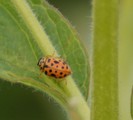
Русские, остановите эту войну! Спасите Свободную Украину!
Russians, stop this war! Save Free Ukraine!
Biodiversity Map
Taxa

Anisosticta — subordinate taxa:
Taxon count: 2
-
Arthropodaphylum
Click to switch
to select orders
and filters > -
Hexapodasubphylum
Click to switch
to select orders
and filters > -
Insectaclass
Click to switch
to select orders
and filters > -
Coleopteraorder
Click to set
as the main taxon
and as a base
← of the left panel > -
Polyphagasuborder
Click to set
as the main taxon
and as a base
← of the left panel > -
Cucujiformiaseries
Click to set
as the main taxon
and as a base
← of the left panel > -
Cucujoideasuperfamily
Click to set
as the main taxon
and as a base
← of the left panel > -
Coccinellidaefamily
Click to set
as the main taxon
and as a base
← of the left panel > -
Coccinellinaesubfamily
Click to set
as the main taxon
and as a base
← of the left panel > -
Tytthaspidinitribe
Click to set
as the main taxon
and as a base
← of the left panel > -
Anisostictagenus
Click to set
as the main taxon
and as a base
← of the left panel >
PL
YES
name status: valid name
BioMap ID: 1019398
taxon code: 3599
taxonomy checked: YES
Data on distribution in Poland

Statistics
- Records: 115
- Publications: 45
- Collections: 11
- Publication authors: 43
- Illustrations (iconography): 1
- Photos (specimen/observation): 7
Taxon description
Szeroko rozprzestrzeniony w Europie od krajów śródziemnomorskich aż po południowe części Anglii, Fennoskandii i Karelii, notowany także z Syberii, Mandżurii, Turkiestanu i Ameryki Północnej. W Polsce, prócz wyższych gór, występuje w całym kraju, ale jest stosunkowo rzadko wykazywany. Zasiedla obszary nizinne i niższe położenia górskie. Występuje w zbiorowiskach roślinnych na terenach bagiennych i torfowiskowych, na wilgotnych łąkach oraz pobrzeżach jezior i rzek. Spotyka się go dość często na opanowanych przez mszyce turzycach, trzcinach, pałkach, mannach i tatarakach. Pojawia się wczesną wiosną i bywa poławiany do października. Nowa generacja ukazuje się w drugiej połowie lipca i na początku sierpnia. Zimuje wewnątrz łodyg trzcin, na ziemi wśród szczątków roślinnych oraz pod odstającą korą drzew rosnących na pobrzeżach wód.
Illustrations
... browse
 Anisosticta
Anisostictanovemdecimpunctata
Photos
... browse
 Anisosticta
Anisostictanovemdecimpunctata
 Anisosticta
Anisostictanovemdecimpunctata
-s.jpg) Anisosticta
Anisostictanovemdecimpunctata
 Anisosticta
Anisostictanovemdecimpunctata
 Anisosticta
Anisostictanovemdecimpunctata
 Anisosticta
Anisostictanovemdecimpunctata
 Anisosticta
Anisostictanovemdecimpunctata
External data sources
- Ostatnie rekordy
-
1035220
 ⊡
⊡ Coccinellidae: Anisosticta novemdecimpunctata, PL, Podlasie, Narwiański P.N., podlaskie, Białystok, Choroszcz, UTM FD28, 2013, leg. A. Kołodko
Coccinellidae: Anisosticta novemdecimpunctata, PL, Podlasie, Narwiański P.N., podlaskie, Białystok, Choroszcz, UTM FD28, 2013, leg. A. Kołodko -
1032823
 ⊡
⊡ Coccinellidae: Anisosticta novemdecimpunctata, PL, Nizina Wielkopolsko-Kujawska, lubuskie, Słubice, Słubice, rez. Łęgi koło Słubic, UTM VT79, 2014
Coccinellidae: Anisosticta novemdecimpunctata, PL, Nizina Wielkopolsko-Kujawska, lubuskie, Słubice, Słubice, rez. Łęgi koło Słubic, UTM VT79, 2014 -
1031411
 ⊡
⊡ Coccinellidae: Anisosticta novemdecimpunctata, PL, Pojezierze Pomorskie, kujawsko-pomorskie, Sępólno Krajeńskie, Więcbork, UTM XV61, 2015, leg. D.J. Tarnawski
Coccinellidae: Anisosticta novemdecimpunctata, PL, Pojezierze Pomorskie, kujawsko-pomorskie, Sępólno Krajeńskie, Więcbork, UTM XV61, 2015, leg. D.J. Tarnawski -
1031410
 ⊡
⊡ Coccinellidae: Anisosticta novemdecimpunctata, PL, Pojezierze Pomorskie, kujawsko-pomorskie, Sępólno Krajeńskie, Więcbork, UTM XV61, 2013, leg. D.J. Tarnawski
Coccinellidae: Anisosticta novemdecimpunctata, PL, Pojezierze Pomorskie, kujawsko-pomorskie, Sępólno Krajeńskie, Więcbork, UTM XV61, 2013, leg. D.J. Tarnawski -
1031409
 ⊡
⊡ Coccinellidae: Anisosticta novemdecimpunctata, PL, Pobrzeże Bałtyku, pomorskie, Gdańsk, Gdańsk, UTM CF32, 2015, leg. D.J. Tarnawski
Coccinellidae: Anisosticta novemdecimpunctata, PL, Pobrzeże Bałtyku, pomorskie, Gdańsk, Gdańsk, UTM CF32, 2015, leg. D.J. Tarnawski -
1031408
 ⊡
⊡ Coccinellidae: Anisosticta novemdecimpunctata, PL, Pobrzeże Bałtyku, Nadmorski P.K., pomorskie, Puck, Puck w., UTM CF35, 2016, leg. D.J. Tarnawski
Coccinellidae: Anisosticta novemdecimpunctata, PL, Pobrzeże Bałtyku, Nadmorski P.K., pomorskie, Puck, Puck w., UTM CF35, 2016, leg. D.J. Tarnawski -
774523
 ⊡
⊡ Coccinellidae: Anisosticta novemdecimpunctata, PL, Wzgórza Trzebnickie, Wilczyn ad Oborniki Śląskie, UTM XS38, 1994, leg. L. Borowiec, coll. Uniw. Wrocławski, ZBiTE
Coccinellidae: Anisosticta novemdecimpunctata, PL, Wzgórza Trzebnickie, Wilczyn ad Oborniki Śląskie, UTM XS38, 1994, leg. L. Borowiec, coll. Uniw. Wrocławski, ZBiTE -
774522
 ⊡
⊡ Coccinellidae: Anisosticta novemdecimpunctata, PL, Pojezierze Pomorskie, Białowieża, UTM XV70, 1991, leg. J. Kania, coll. Uniw. Wrocławski, ZBiTE
Coccinellidae: Anisosticta novemdecimpunctata, PL, Pojezierze Pomorskie, Białowieża, UTM XV70, 1991, leg. J. Kania, coll. Uniw. Wrocławski, ZBiTE -
720170
 ×
× Coccinellidae: Anisosticta novemdecimpunctata, PL, Łobanowo, coll. IOR
Coccinellidae: Anisosticta novemdecimpunctata, PL, Łobanowo, coll. IOR -
720071
 ×
× Coccinellidae: Anisosticta novemdecimpunctata, PL, coll. IOR
Coccinellidae: Anisosticta novemdecimpunctata, PL, coll. IOR - ... more
- Powiązane publikacje
-
Przewoźny M. 2007a. Chrząszcze (Coleoptera) okolic Jeziora Maltańskiego w Poznaniu. Nowy Pam. Fizjogr., 5:29-48.
 Show records
Show records -
Gutowski J.M., Ruta R. 2004. Waloryzacja przyrodnicza gminy Tuczno (Pojezierze Zachodniopomorskie) w oparciu o wyniki wstępnych badań nad chrząszczami (Insecta: Coleoptera). Nowy Pam. Fizjogr., 3:27-60.
 Show records
Show records -
Ruta R., Melke A. 2002. Chrząszcze (Insecta: Coleoptera) rezerwatu „Kuźnik” koło Piły. Roczn. Nauk. PTOP „Salamandra”, 6:57-101.
 Show records
Show records -
Pietrykowska-Tudruj E., Stączek Z.Z. 2001a. Biedronkowate (Coleoptera: Coccinellidae) Poleskiego Parku Narodowego i okolic. Część I. Parki Nar. Rez. Przyr., 20(1):55-62.
 Show records
Show records -
Stączek Z.Z. 1990. Biedronki (Coleoptera, Coccinellidae) zespołu grądowego (Tilio-Carpinetum) w rezerwacie Bachus (Wyżyna Lubelska). Fragm. Faun., 33:373-382.
 Show records
Show records - ... more






